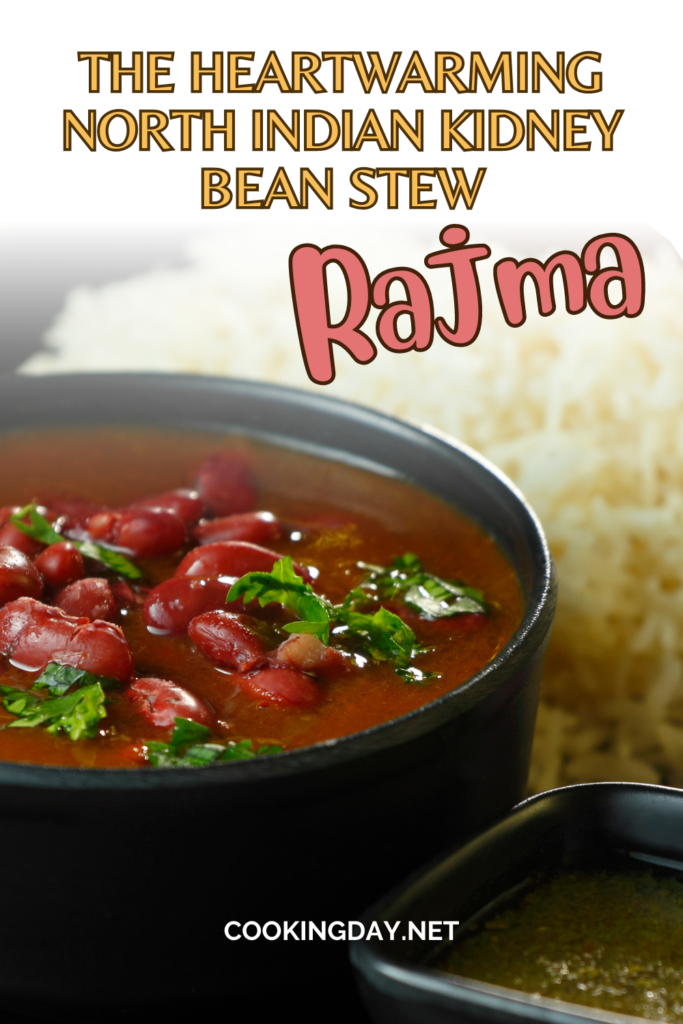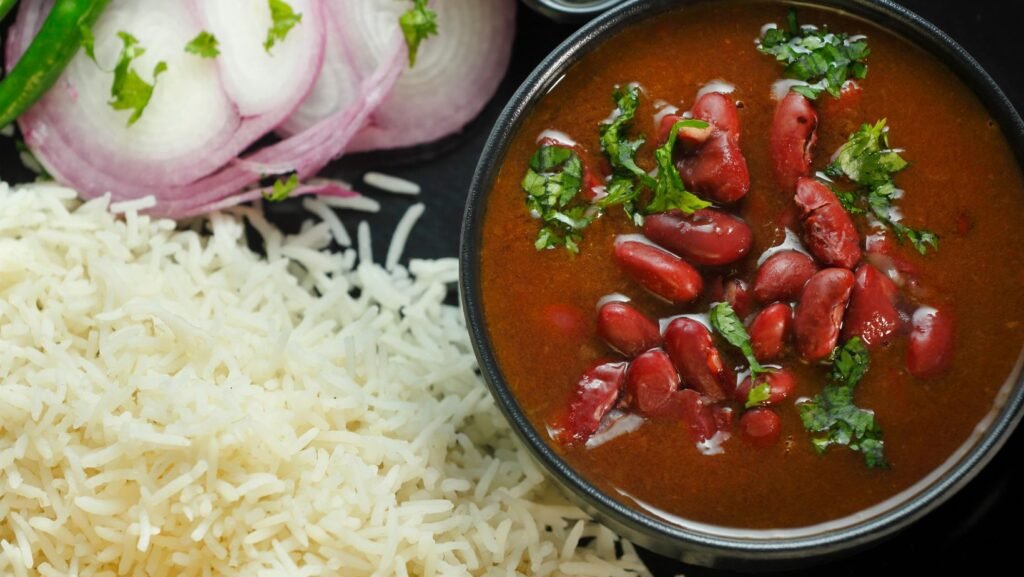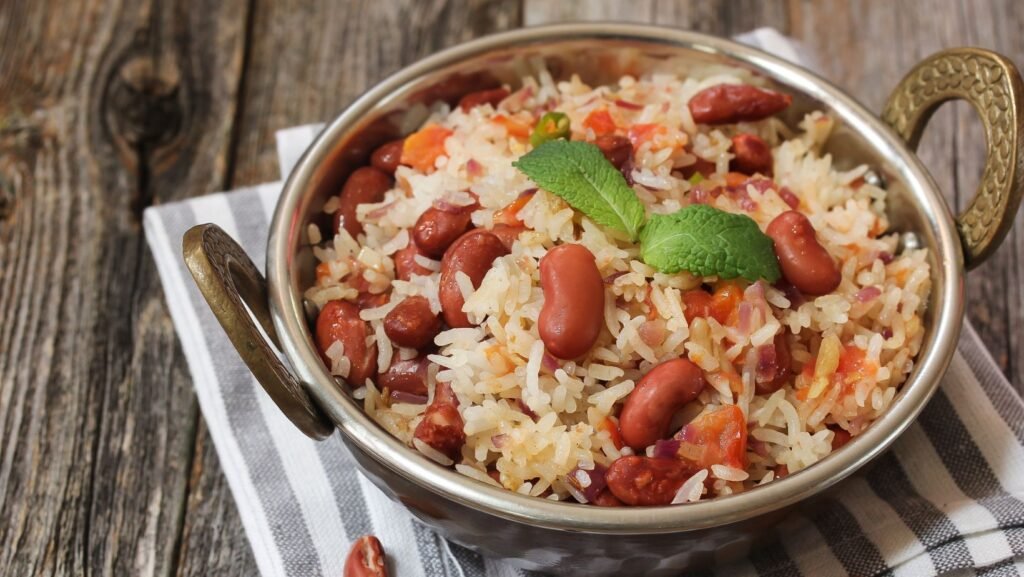Some links on this page are affiliate links. This means we may earn a commission at no additional cost to you if you click through and make a purchase, you can check our Affiliate Disclosure. Thank you for your support!
Imagine stepping into a North Indian kitchen and being greeted by the warm, earthy aroma of Rajma simmering on the stove. This kidney bean stew, a staple in many homes, not only fills the room with its inviting scent but also promises a comforting and satisfying meal. In North Indian households, Rajma isn’t just food; it’s a culinary heritage, bringing families together with every bite.
With its rich, hearty beans and a blend of spices, It is more than just a dish—it’s a celebration of flavor and tradition. Loved by all ages, it’s the go-to comfort food that never fails to delight. Whether it’s a lazy Sunday lunch or a special gathering, It holds a special place in the hearts and plates of many.
In this journey, we’ll dive into the fascinating history of it, understand its cultural significance, and learn how to whip up this delicious stew. Plus, we’ll explore some interesting variations that have emerged over time. So, let’s embark on this flavorful adventure and discover why Rajma is such an integral part of North Indian cuisine! 🍲🌶️🧅🍚

What is Rajma?
So, what exactly is Rajma? At its heart, It is a soul-warming stew made primarily with red kidney beans. These beans, known for their robust texture and ability to soak up flavors, are slow-cooked with a blend of spices, tomatoes, onions, and garlic. The result? A thick, flavorful gravy that’s both comforting and deeply satisfying.
In North Indian cuisine, Rajma isn’t just another dish; it’s a star. You’ll often find it on the dining table during family gatherings, lazy weekend lunches, and sometimes, just because it’s so darn good. It’s a dish that reminds many of home and the simple pleasures of a meal cooked with love.
Nutritional Value of Rajma
Now, let’s talk health because Rajma is not just tasty; it’s also packed with goodness. Kidney beans, the main ingredient, are a powerhouse of nutrition. They’re loaded with fiber, which is great for your digestive system. Additionally, they’re a great source of protein—especially for those who follow a vegetarian or vegan diet. 🌿💪
But that’s not all. Rajma offers iron, which keeps your energy levels up, and a decent amount of antioxidants. These little beans help manage blood sugar levels too, making Rajma a wholesome choice for just about anyone. In a nutshell, Rajma is more than a treat for your taste buds; it’s a boon for your overall health.
The Cultural Significance of Rajma
Historical Background
Rajma’s journey in North Indian cuisine goes way back. While the exact origins are a bit fuzzy, it’s widely believed that Rajma came to India through Central Mexico and Guatemala. Once it reached the vibrant lands of North India, it found a special place in the region’s culinary heart. Over time, it blended seamlessly with local flavors and cooking techniques, turning into the Rajma we know and love today.
Rajma in Daily Life
In everyday life, Rajma is more than just a dish; it’s a comfort food that brings back memories and creates new ones. In many North Indian homes, you’ll see it making a regular appearance. It’s often served with rice, and this combo, fondly called “Rajma Chawal,” is a favorite for lunch or dinner. 🍛
But it’s not just about the taste. It is also about the moments shared around the dining table. It’s the dish families bond over on lazy Sunday afternoons and the comfort food students crave when they’re away from home. It’s a simple, hearty meal that symbolizes warmth, love, and the joys of a home-cooked meal.
Rajma in Festivals and Celebrations
When it comes to festivals and celebrations, It has its special place too. While not typically a festival food, it’s often part of the lavish spreads during family gatherings and social events. It’s the dish that adds richness and heartiness to any meal, making it perfect for people coming together to celebrate.
It is cooked with extra care during special occasions, ensuring the flavors are just right – a perfect blend of spicy, savory, and a tiny hint of sweet. It’s served with pride and often becomes the talk of the table, with guests asking for the recipe before they leave.
In short, It isn’t just a dish in North India; it’s a part of the region’s soul. It represents a blend of history, culture, and the simple yet profound joy of eating a meal that’s cooked with love. 🌟🍲
Authentic Rajma Recipe
Ready to cook up some delicious Rajma? Let’s dive into the ingredients you’ll need and the steps to make this heartwarming dish.
Ingredients List
Here’s what you’ll need for your Rajma:
- Red kidney beans (Rajma) – 1 cup, soaked overnight
- Water – for boiling the beans
- Onions – 2 medium, finely chopped
- Tomatoes – 2 large, pureed
- Ginger-garlic paste – 1 tbsp
- Green chilies – 2, finely chopped (adjust to taste)
- Cumin seeds (Jeera) – 1 tsp
- Turmeric powder (Haldi) – ½ tsp
- Red chili powder – 1 tsp (adjust to taste)
- Coriander powder (Dhania) – 2 tsp
- Garam masala – 1 tsp
- Salt – to taste
- Cooking oil or ghee – 2 tbsp
- Fresh coriander leaves – for garnishing
- Cream or butter – 1 tbsp (optional, for richness)
Step-by-Step Cooking Instructions
Prepare the Rajma:
- Rinse the soaked Rajma and boil in a pressure cooker with enough water until soft (about 15-20 minutes after the first whistle).
- Once done, set aside. Don’t drain the water; you’ll need it later!
Cook the Base:
- Heat oil or ghee in a pan. Add cumin seeds and let them sizzle.
- Add the chopped onions and sauté until golden brown.
- Stir in the ginger-garlic paste and green chilies. Cook for a minute.
Add the Spices:
- Mix in the turmeric, red chili, and coriander powder. Sauté for a few seconds.
- Once the oil separates from the sides, pour in the tomato puree and continue to cook.
Combine Everything:
- Add the boiled Rajma along with its water.
- Stir in salt and let it simmer for 10-15 minutes. The gravy should thicken.
Final Touch:
- Add garam masala and cream or butter for extra richness.
- Cook for another 5 minutes. Check the consistency; it should be thick but pourable.
Garnish:
- Garnish with chopped coriander leaves.
Tips for Perfect Rajma
- Quality of Rajma: Always choose high-quality Rajma for the best flavor.
- Soaking Time: Ensure the Rajma is soaked well, ideally overnight, to reduce cooking time.
- Slow Cooking: Let the Rajma simmer on low heat to enhance the flavors.
- Spice Balance: Adjust the spices to suit your taste, but don’t overpower the natural flavor of the beans.
- Consistency Check: The gravy should be thick; if it’s too watery, simmer for longer.
And there you have it – a bowl of heartwarming Rajma, perfect for pairing rice or roti. Enjoy your cooking adventure! 🥣👩🍳🌿
Variations of Rajma
Regional Variations
Rajma, like many classic dishes, varies a bit from place to place. Let’s see how different regions in North India put their unique spin on this beloved dish:
- Kashmiri Rajma: This version is usually made with smaller, darker Rajma and is less spicy. The Kashmiri Rajma is known for its rich and thick gravy, often flavored with fennel and dried ginger.
- Punjabi Rajma: A bit heartier and richer, the Punjabi style typically uses lots of onions, tomatoes, and ghee. It’s also more generous with spices, making it a bolder, more robust dish.
- Himachali Rajma: Often prepared with local herbs and less tomato, this variation might include yogurt and asafoetida for a distinct flavor.
Each region brings its taste to the table, making Rajma a dish and a culinary journey through North India.
Modern Adaptations
Rajma is getting some cool modern makeovers too:
- Rajma Tacos or Wraps: A fusion twist, where spicy Rajma fills tacos or wraps, often with a dollop of yogurt or sour cream.
- Rajma Salad: Chilled Rajma mixed with fresh veggies and a tangy dressing – perfect for a healthy, filling lunch.
- Rajma Burgers: Mashed Rajma patties spiced up and grilled, making for a delicious vegetarian burger.
These modern takes keep Rajma relevant and exciting for every generation.
Accompaniments
Wondering what to serve with Rajma? Here are some classic combos:
- Rajma Chawal: The classic – Rajma paired with steaming hot rice. It’s comfort food at its best. 🍚
- Roti or Naan: Scoop up the Rajma with some fresh, warm roti or naan for a delightful meal.
- Green Salad: Rajma’s richness can be countered with a simple green salad with a zesty dressing.
- Raita: A cool, yogurt-based side like cucumber or boondi raita complements the spicy Rajma well.
- Pickle and Onions: A bit of tangy pickle and some sliced onions on the side can enhance the Rajma eating experience.
So, there you have it – the many delicious faces of Rajma! From traditional to trendy, and from North Indian kitchens to yours, Rajma is a versatile and beloved dish. 🌶️🍲🥙
Pairing Rajma with Other Dishes
Ideal Combinations
When pairing Rajma with other dishes, the possibilities are both delicious and diverse. Here are some classic and popular combinations that bring out the best in Rajma:
- Rice: The all-time favorite is Rajma with steamed basmati rice. This combo, Rajma Chawal, is a staple in many North Indian homes. The fluffy rice complements the thick Rajma gravy perfectly. 🍚
- Breads: Rajma also goes well with various Indian breads. Try it with soft naan, roti, or paratha for a heartier meal. Each bread brings a different texture and flavor to the table, making the Rajma experience richer.
- Jeera Rice: To level up your rice game, pair Rajma with jeera (cumin) rice. The aromatic cumin seeds in the rice add a delightful flavor contrast to the Rajma.
- Pulao: A mildly flavored pulao can also be a great accompaniment to Rajma, especially if you’re looking for a more elaborate meal.
ALSO READ: Jollof Rice Perfection: Capturing the Essence of West African Cuisine
Serving Suggestions
Presentation is key when serving Rajma. Here are some tips to make your Rajma dish look as good as it tastes:
- Colorful Garnish: Sprinkle chopped fresh coriander or parsley on top of the Rajma before serving. This adds a pop of color and a fresh flavor.
- A Dollop of Cream: Add a small dollop of cream on top of the Rajma for a rich and appealing look. This is especially popular in restaurant-style presentations.
- Side Salad: Serve with fresh salad for a burst of color and a crunchy texture contrast. Think sliced cucumbers, tomatoes, onions, and a sprinkle of lemon juice.
- Serve in Traditional Cookware: If you have it, serve Rajma in traditional Indian cookware like a copper handi or a clay pot. This adds an authentic and rustic touch to your meal.
- Layering: When serving Rajma with rice, try layering – a layer of rice, then Rajma, followed by another layer of rice. This not only looks appealing but also allows the flavors to mingle beautifully.
Remember, the key to a great Rajma meal is the taste and how you present it. A well-served Rajma dish can turn an ordinary meal into a feast for the senses! 🌿🍛🍽️
Adapting Rajma for Various Diets
Dietary Considerations
Rajma is naturally gluten-free and vegetarian, making it a great choice for many diets. But what if you have specific dietary needs? Don’t worry; with a few tweaks, you can still enjoy this delicious dish:
- Vegan Rajma: The traditional Rajma recipe is almost vegan, except for ghee or butter. Swap these for plant-based oils, and you’re good to go! 🌱
- Low-Calorie Rajma: To make Rajma lower in calories, reduce the amount of oil used for cooking. Also, consider skipping high-calorie ingredients like cream. Increase the tomato content for a richer gravy without extra calories.
- Low-Sodium Rajma: If you’re watching your salt intake, use less salt and increase the herbs and spices to compensate for flavor.
Healthier Alternatives
Want to make your Rajma even healthier without losing out on taste? Here are some tips:
- Use Fresh Ingredients: Opt for fresh tomatoes, onions, and herbs instead of canned or processed alternatives. It boosts flavor and ensures you’re eating whole, unprocessed foods.
- Increase Fiber and Nutrients: Add vegetables like spinach, bell peppers, or carrots to your Rajma. They blend well with the gravy and add extra nutrition and fiber.
- Whole Grain Accompaniments: Instead of white rice, serve your Rajma with whole grains like brown rice, quinoa, or whole wheat chapatis. This switch adds fiber and nutrients to your meal.
- Healthy Fats: Choose healthier types of oil, such as canola or olive oil, if you use any. They’re better for your heart.
- Control Portion Sizes: Rajma is filling, so watch your portion sizes to keep calories in check.
Remember, adapting Rajma to fit your dietary needs doesn’t mean you have to compromise on flavor. With these simple modifications, you can enjoy this classic dish in a way that suits your lifestyle and health goals. Happy cooking and eating! 🍲🥦🍅🍚🥗🌿
ALSO READ:Discovering the Delights of Filipino Adobo: A Culinary Journey
To Wrap Up
Let’s take a moment to reflect on our journey with Rajma, the heartwarming North Indian dish that’s as nourishing for the soul as it is for the body.
- What Rajma Is: We learned that it is a delectable kidney bean stew, deeply rooted in North Indian cuisine. It’s a blend of red kidney beans, aromatic spices, and herbs slow-cooked to perfection, creating a rich and hearty dish.
- Its Nutritional Punch: it isn’t just tasty; it’s a powerhouse of nutrition. Packed with protein, fiber, and essential nutrients, it’s a guilt-free indulgence, especially for those on a vegetarian or vegan diet.
- Cultural Significance: More than just a meal, It holds a special place in the hearts of North Indians. It’s associated with family, comfort, and tradition, making it a staple in daily meals and festive occasions.
- The Classic Recipe: We dove into the authentic Rajma recipe, a simple yet satisfying cooking adventure that promises to delight everyone at the dining table.
- Variations and Pairings: It’s versatility was showcased from regional twists to modern adaptations. We also discussed ideal pairings like Rajma Chawal (with rice) and how to serve it for maximum appeal.
- Dietary Adaptations: We explored how Rajma can be modified for various dietary needs without losing its essence, ensuring everyone can enjoy this delightful dish.
Rajma is not just food; it’s a part of North Indian culture, a symbol of home cooking, and a testament to India’s rich, diverse culinary landscape. Its simplicity and the depth of flavor make it a must-try for anyone interested in exploring Indian cuisine.
So, why not bring a taste of North India into your kitchen? Grab some kidney beans, your favorite spices, and let the magic of it unfold in your pot. And don’t stop there; dive deeper into the world of North Indian dishes and discover more flavors and stories waiting to be relished. Happy cooking and enjoy your culinary adventure! 🍲🌟👩🍳🌿🥘



